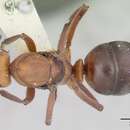en
names in breadcrumbs


Taxonomic history
Mayr, 1886d PDF: 425 (q.m.).Subspecies of Formica rufa: Emery, 1893k PDF: 652; Wheeler, 1908k PDF: 406; Creighton, 1940a PDF: 1.Subspecies of Formica truncicola: Wheeler, 1913d PDF: 116; Wheeler, 1913i PDF: 444; Wheeler, 1917a PDF: 464.Revived status as species: Creighton, 1950a PDF: 487.Senior synonym of Formica integra similis: Emery, 1893k PDF: 652; Wheeler, 1906g PDF: 16.Formica integra , Nyl. Form. Fr. et d'Alger. 62 (note).
Worker. Length 4 1/2 lines. - Rufo-ferruginous: abdomen black; closely resembling the F. sanguinea , but the clypeus has not the small central notch which characterizes that species. Head large, much wider than the thorax, excavated behind; the clypeus subcarinated in the middle. Thorax narrowed posteriorly; the scale of the peduncle incrassate, its apex obtuse; head, thorax and abdomen thinly sprinkled with ferruginous hairs.
Hab. United States.
The insect described is doubtless the large form of the worker, and probably the same as that to which Dr. Nylander refers in his note: we have adopted the name which he proposed on that supposition. In the collection of the Museum are specimens from North America, agreeing in every respect with the F. sanguinea of Europe.
Smith's F. integra im Catal. p. 54 kann unmoeglich die Nylander'sche Art sein, denn Herr Smith stellt sie in die zweite Subdivision und schreibt: „ head, thorax and abdomen thinly sprinkled with ferruginous hairs ", waehrend Nylander's integra, welche ich von Herrn Dr. Sichel besitze und von welchem sie auch Dr. Nylander hatte, oben nicht (wie z. B. truncicola, congerens) behaart ist. Schon vor laengerer Zeit, damals noch der Meinung, dass Smith die echte Nylander'sche Art beschrieben habe, schrieb ich Herrn Smith, dass er F. integra irrigerweise in die zweite Subdivision seiner Gattung Formica gestellt habe, doch erhielt ich auf diese Notiz keine Bemerkung zurueck. Diese Art ist sehr aehnlich der F. sanguinea und unterscheidet sich von ihr nur durch den ganz rothen Kopf und Thorax, durch den Mangel der abstehenden Behaarung an der Oberseite des Koerpers und durch den nicht ausgerandeten Clypeus. Einen [[ worker ]] besitzt das Mus. caes. aus Nordamerika.
Formica integra is a species of ant in the family Formicidae.[1][2][3][4]
Formica integra is a species of ant in the family Formicidae.